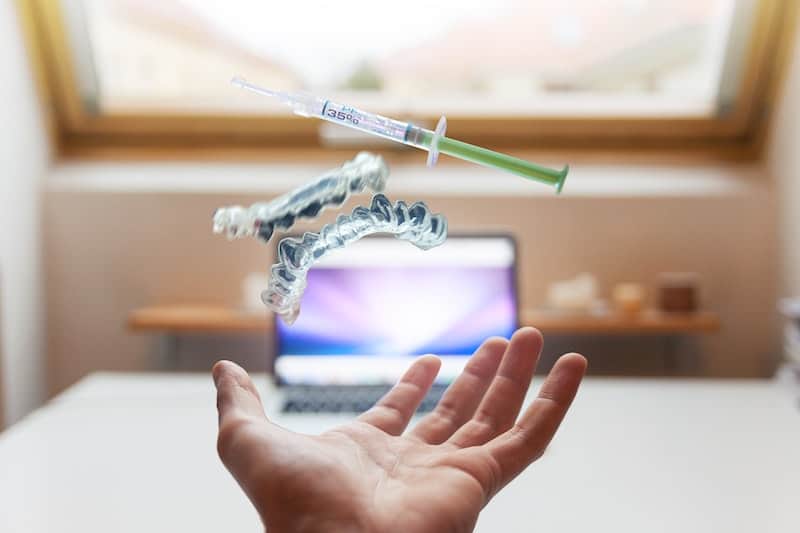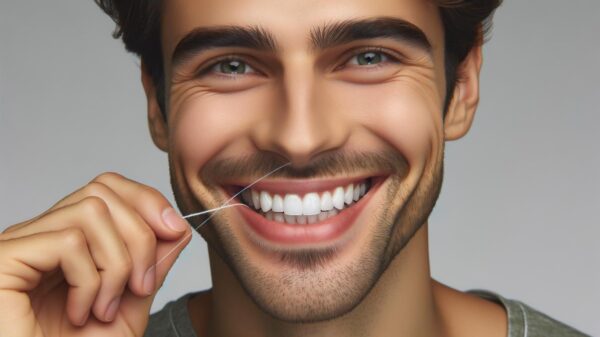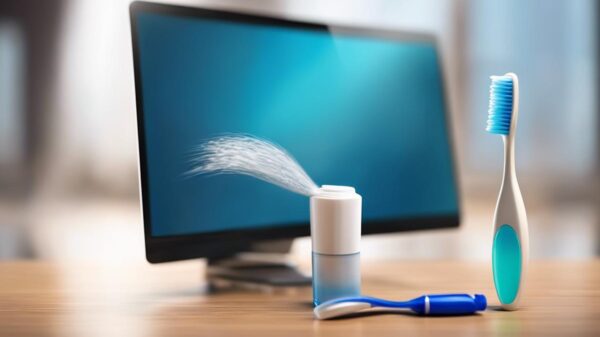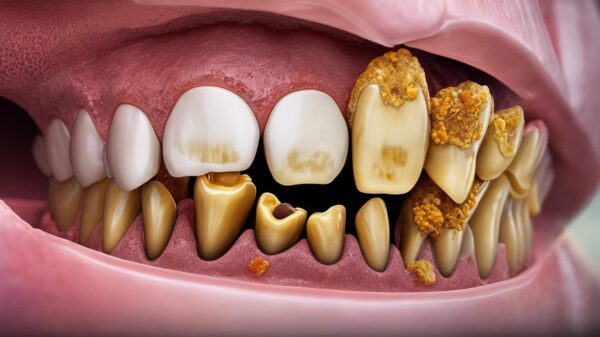What You Need to Know About Whitening Teeth With Invisalign
You’ve finally decided to straighten your pearly whites. As an adult, you may be gravitating toward clear, low-profile Invisalign® aligners. This orthodontic system treats a wide range of bite misalignment, from simple to complex. It does all that with clear, removable teeth trays.
Many of our patients who choose Invisalign® clear aligners are also seeking to whiten their teeth for the ultimate, perfect smile. But orthodontists are split on if you can whiten your teeth with braces or Invisalign.
So, can you whiten your teeth while using Invisalign? In a nutshell, the answer to whether people can whiten teeth while wearing Invisalign® aligners is yes. However, the decision should be made with supervision and advice from a dental professional due to several factors.
Keep reading to learn more about the Invisalign process and things to consider before whitening your teeth with Invisalign.
What is Invisalign?
Before we dive into our conversation about whitening your teeth with Invisalign, let’s take a look at the Invisalign process.
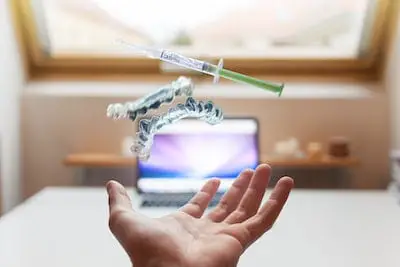 Consultation: The first step for all cases is to schedule a consultation with an Invisalign provider. Together, goals and estimated timelines will be discussed, and a treatment plan will be created unique to the patient.
Consultation: The first step for all cases is to schedule a consultation with an Invisalign provider. Together, goals and estimated timelines will be discussed, and a treatment plan will be created unique to the patient.- Digital Scans: As part of the planning process, a 3D scan of the patient’s mouth will be created. This allows the doctor to see exactly what movements need to be made, as well as precisely how long the process will take.
- Aligners: Based on the 3D scans, a set of personalized aligners will be made to ensure proper alignment at the end of treatment.
- Other Customizations: For some cases, Invisalign attachments like buttons may be added to the treatment for more precise tooth movement.
You can learn more about the Invisalign process and whether Invisalign works faster than braces here.
Differences Between Toothpastes, Mouthwashes, and Whitening Gels
One of the best teeth whitening methods to use during Invisalign treatment is over the counter products such as toothpaste, mouthwashes, and whitening gels.
Whitening Toothpaste and Mouthwashes
Often, less intense forms of tooth whitening such as the use of toothpaste or mouthwashes with whitening agents can be helpful for those who wear aligners. Wearers have reported that the aligners help to keep the whitening agents in close proximity to their teeth, providing greater whitening action. Such whitening agents can help break down surface stains, while tiny abrasive particles can scrub and polish the surface of the teeth.
Whitening Gels
Some dentists may be able to prescribe whitening gels to either apply in the dental office or at home. These gels are a little more intense than average whitening toothpaste and mouthwashes. They often come with specific instructions for their use to avoid causing tooth sensitivity. You can learn more about getting your teeth whitened at the dentist here.
How to Prevent Teeth Stains While Wearing Invisalign®
Put a stop to further teeth discoloration with these stain-fighting habits:
- Brush after eating and drinking
- Add milk to black coffee and tea to reduce their stain-causing power
- Know which foods are major stainers and enjoy in moderation (BBQ sauce, curry sauce, tomato sauce, beets)
You’ll want to keep your aligners as clear and stain-free as possible, as well. They’ll look much more visible if they discolor. Here are a few tips:
- Never eat or drink anything other than water while the aligners are on your teeth
- Don’t smoke
- Brush your teeth before replacing the aligners after a meal or beverage
- Follow our instructions for cleaning the aligners
Caring for your smile while wearing Invisalign goes beyond just waiting for your teeth to get straighter. It involves cleaning your teeth regularly and thoroughly to prevent tooth decay. That way, your smile will be more beautiful than ever when you’re done with your Invisalign treatment.
Take Your Trays Out
The first difference you may notice between Invisalign and traditional metal braces is that Invisalign aligners are invisible, but there’s another important distinction as well. Invisalign braces are removable. You can take the trays out, and you should. Remove the trays while you’re eating so you don’t get food stuck in them. Also, remove them while you’re cleaning your teeth so that you can have full access to all the nooks and crannies in your mouth.
Brush Normally
The guidelines for brushing your teeth with Invisalign don’t change compared to braces. Brush your teeth at least twice a day using a soft toothbrush and fluoride toothpaste, being sure to get all surfaces of your teeth. If possible, brush after each meal.
If you can’t, be sure to drink some water and swish it around in your mouth when you’re done eating to get rid of the extra food on your teeth. Leaving carbohydrates, such as sugar and starch, on your teeth opens the door to tooth decay.
Floss and Wash
Flossing your teeth gets out the bits and pieces stuck between them. It’s a time-consuming task when you need to navigate the wires of traditional metal braces, but thanks to Invisalign’s removable design, flossing is no problem. Rinsing your mouth with a fluoride antibacterial mouthwash also helps clean your teeth because it gets into all of the spaces. Floss and rinse one or two times daily.
Cleaning Your InvisalignTrays
Cleaning your Invisalign trays keeps them from getting riddled with bacteria, and it helps keep your teeth free from excess food. You can use the Invisalign cleaning system, which involves placing the trays in a tub with cleaning crystals. The plastic trays are clean after 15 minutes. You can also ask our doctors for other ways to clean your trays.
Is the Invisalign® Aligner a Tooth Whitening Tray?
No. Despite being shaped similarly, the aligner is not the same thing as a tooth whitening tray and should not be used as one. The aligner is fitted to be much tighter against the teeth of the wearer and therefore will push out any whitening gel applied to the inside of the aligner. This can be irritating to the lining of the mouth and the stomach of the patient.
Should I Whiten My Teeth While Wearing Invisalign® Aligners?
Many dentists and dental professionals recommend waiting until after the teeth are correctly aligned before starting a procedure of teeth whitening. Since the teeth are moving constantly during the alignment process, new discoloration could appear from areas of the teeth that were not exposed to whitening agents. This can lead to a displeasing final appearance. By waiting until the teeth are aligned, the wearer can more easily achieve an even and bright smile.
The good news is since you remove your aligners to eat and drink, Invisalign® helps you avoid teeth stains that can sometimes result from poor hygiene while wearing metal braces. Metal brackets and wires provide a snag for food debris to catch on, so it is important to rinse, brush, and floss while wearing braces to prevent decay and stains.
You remove Invisalign® aligners when you eat, and whenever you drink anything other than water. Therefore, there is no opportunity for food to become stuck in your orthodontia. You brush away food debris before re-inserting the trays, so the food won’t have a chance to sit on the enamel.
Reasons to Delay Whitening Until After Invisalign®
In addition to the primary concerns of additional discoloration listed above, there are a few other reasons you should consider waiting to whiten your teeth until after finishing your Invisalign treatment!
- Teeth surfaces will be newly exposed. As crooked and crowded teeth straighten, new sides of the tooth may be exposed or oriented to the front of your smile. If you were to whiten your teeth before treatment is complete, then you are likely to have unevenly whitened teeth. The newly exposed enamel may need to be whitened after treatment anyway, in order to get a consistently white smile.
- Teeth sensitivity. Most whitening treatments cause sensitivity and may irritate your gums. Orthodontic treatment tends to cause discomfort because the teeth are moving and the bone is remodeling. You don’t want to add teeth sensitivity on top of orthodontic soreness.
Conclusion
Whitening of the teeth is possible through the use of whitening toothpaste, gels, and mouthwashes. However, many dental professionals recommend that patients begin whitening their teeth after alignment is complete. Caring for teeth during realignment should involve good dental hygiene habits such as brushing and flossing. These habits can help improve the appearance of teeth in the interim.
Having your teeth whitened or otherwise enhanced will be a nice way to reward yourself after you’ve completed your Jenks Invisalign treatment.



